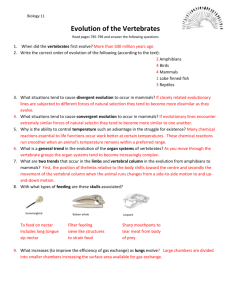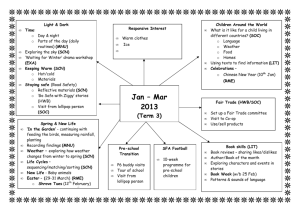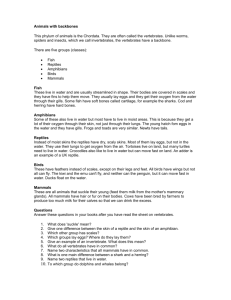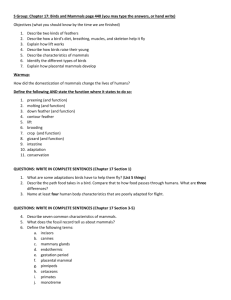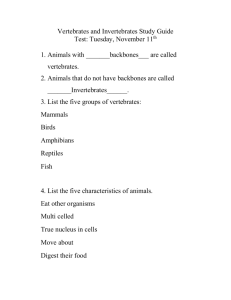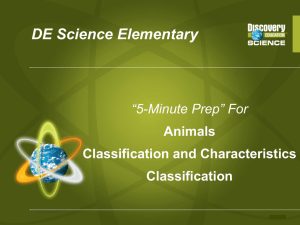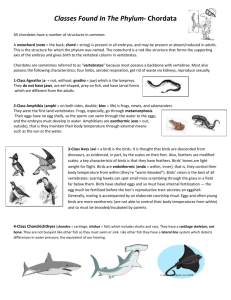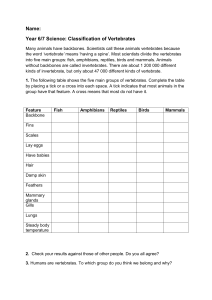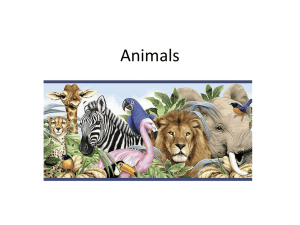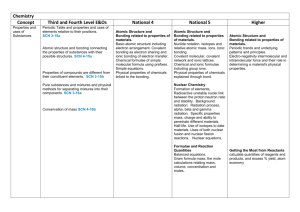These notes explain how to run the `Back to our Roots
advertisement
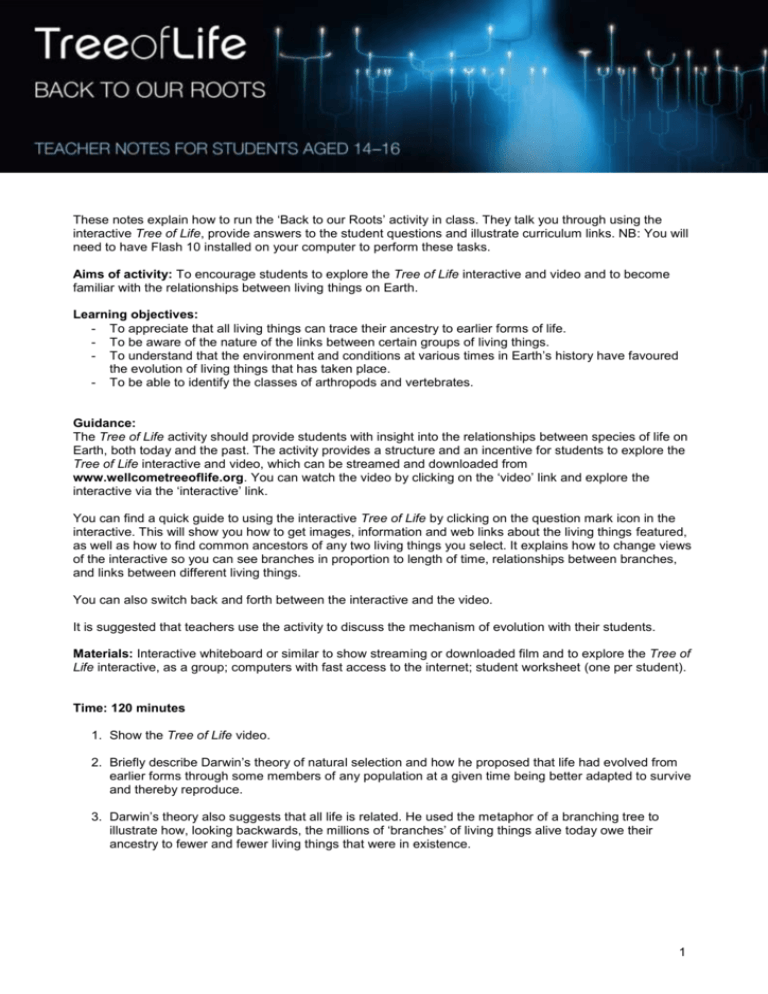
These notes explain how to run the ‘Back to our Roots’ activity in class. They talk you through using the interactive Tree of Life, provide answers to the student questions and illustrate curriculum links. NB: You will need to have Flash 10 installed on your computer to perform these tasks. Aims of activity: To encourage students to explore the Tree of Life interactive and video and to become familiar with the relationships between living things on Earth. Learning objectives: - To appreciate that all living things can trace their ancestry to earlier forms of life. - To be aware of the nature of the links between certain groups of living things. - To understand that the environment and conditions at various times in Earth’s history have favoured the evolution of living things that has taken place. - To be able to identify the classes of arthropods and vertebrates. Guidance: The Tree of Life activity should provide students with insight into the relationships between species of life on Earth, both today and the past. The activity provides a structure and an incentive for students to explore the Tree of Life interactive and video, which can be streamed and downloaded from www.wellcometreeoflife.org. You can watch the video by clicking on the ‘video’ link and explore the interactive via the ‘interactive’ link. You can find a quick guide to using the interactive Tree of Life by clicking on the question mark icon in the interactive. This will show you how to get images, information and web links about the living things featured, as well as how to find common ancestors of any two living things you select. It explains how to change views of the interactive so you can see branches in proportion to length of time, relationships between branches, and links between different living things. You can also switch back and forth between the interactive and the video. It is suggested that teachers use the activity to discuss the mechanism of evolution with their students. Materials: Interactive whiteboard or similar to show streaming or downloaded film and to explore the Tree of Life interactive, as a group; computers with fast access to the internet; student worksheet (one per student). Time: 120 minutes 1. Show the Tree of Life video. 2. Briefly describe Darwin’s theory of natural selection and how he proposed that life had evolved from earlier forms through some members of any population at a given time being better adapted to survive and thereby reproduce. 3. Darwin’s theory also suggests that all life is related. He used the metaphor of a branching tree to illustrate how, looking backwards, the millions of ‘branches’ of living things alive today owe their ancestry to fewer and fewer living things that were in existence. 1 4. Using an interactive whiteboard or a large projection screen, pick out some moments from the Tree of Life video and indicate where the event took place on the Tree of Life interactive. Encourage students to see how the different configurations of the interactive can be used to help them work out what is happening at different junctures. Select one or two living things and click on the text, images, rotating video and web links. TIME EVENT 0:47 cells formed 1:17 internal cavity 1:54 development of sense organs 2:10 hard protective skin 2:24 some armoured invertebrates venture onto land 2:49 wings appear – insects arrive and life moves into the air for the first time 3:10 the development of a backbone, skull and hinged jaw for some animals in the sea 3:40 backboned living things on the land 4:05 first truly terrestrial animals – with dry skin and egg with watertight shell 4:28 destruction of much of life on Earth, especially the dinosaurs 4:53 arrival of the mammals 5. Ask students to work through the accompanying worksheet titled ‘Back to our Roots’. Key concepts: 2 - The reason we classify living things in a branching structure is because, according to Charles Darwin, all life shares common ancestry. The branching tree shows the relative closeness or distance of living things to one another. There were particularly significant stages in the development of animals, relating to the development of a hollow body cavity, repeating segments in the body plan for greater specialisation, the appearance of jointed limbs, formation of biting mouthparts and jaws, the development of sense organs, insect wings, adaptations that enabled land vertebrates to exist out of the water and being ‘warm-blooded’. 3 Answers to questions: 1. Escherichia coli (E. coli). This bacterium is found in large quantities in the gut of mammals. 2. Since sponges have few specialised cells, they cannot really move and rely on currents of water bringing food to them. 3. The small ‘feet’ organs allow the velvet worm to move and propel itself along. Consequently the velvet worm is better able to locate its food source and to escape predators than unsegmented relatives. 4. a) The currents and buoyancy of sea water would make it easier for early invertebrates to live in the sea – especially for insects the size of the sea scorpion. The first insects that walked on land had an exoskeleton and jointed legs as well as voluntary muscle, which enables insects to move more quickly. Ultimately it was this combination that led to insect flight. b) ‘Extinction’ is the term given to the complete dying out of a population or species. Animal populations can become extinct when they are no longer suited to the environment in which they live. This could be because a new competitor has come along and is better at obtaining food, or it might be that there is a change in the physical structure of the environment that puts them at a disadvantage. The large species of terrestrial insect and other invertebrates in the Tree of Life may have become extinct when atmospheric oxygen levels decreased significantly. 5. Arthropods all have jointed legs (which is what the name means), a hard exoskeleton and segmented bodies. They are the most plentiful and varied animals on the planet. The classes of arthropods include insects, arachnids, myriapods and crustacea. 6. Fish, amphibians, reptiles, birds and mammals. 7. a) Newt and crocodile: common ancestors were the early tetrapods – animals with four legs. b) Duck and tortoise: common ancestors were early reptiles. c) Rabbit and snake: common ancestors were the early amniota. These include most reptiles, all birds and mammals. What they share in common is a terrestrially adapted egg – whether it is protected by a shell or by a series or membranes within the mother herself. In humans these membranes include the amniotic sac that holds the fluid that protects the baby. a) The fins in water are used to propel the animal but not support its weight. On land the limb would be subject to the stress of supporting the animal’s weight without the benefit of the buoyancy of the water to offset the effects of gravity. b) The fossil record shows many of the gradual stages in the evolution of the pentadactyl (fivefingered) limb of vertebrates. All vertebrates share the same basic plan for this limb, whether they are flying, swimming or walking. 4 9. eggs surrounded by a hard shell has teeth has feathers is warm blooded has fur cares for young early amphibian X X X X X X early reptile X X X X X tyrannosaurus possibly possibly X X archaeopteryx possibly X possibly modern birds X X early mammal X bat X X chimpanzee X X 10. a) Eggs with hard shells meant that vertebrates did not have to go back to the water to lay their eggs. This meant that these vertebrates could live away from the sea and expand their habitats. b) Keeping body temperature warm allows mammals’ and birds’ bodies to function at their maximum capacity. In particular it enables birds and flying mammals to release sufficient energy to fly, and to break a direct dependence on being in warm sunlight. Mammals and some birds 5 can therefore hunt at night. Birds and mammals are also able to live in some of the coldest places on Earth (penguins and polar bears, for example). c) When animals care for their young, there is a greater chance that an individual will survive until it is able to reproduce. As animals became more sophisticated, it takes them longer to reach maturity. Nature has, in some cases, selected intensive parental support to maximise likelihood of survival. 11. Archaeopteryx is thought by some researchers to be a link between reptiles and birds. It has sharp teeth, three fingers with claws like a reptile, but feathers, like a bird. Curriculum links ENGLAND AQA Science A + B Unit 8.3 Evolution and Environment What determines where particular species live and how many of them there are? Why are individuals of the same species different from each other? What new methods do we have for producing plants and animals with the characteristics we prefer? Why have some species of plants and animals died out? How do new species of plants and animals develop? How do humans affect the environment? OCR Twenty First Century Science Module B3: Life on Earth How did life on Earth begin and evolve? How have scientists developed explanations of evolution? How did humans evolve? How are our nervous systems organised? Why do some species become extinct, and does it matter? What is the importance of biodiversity? Module B5: Growth and Development How does an organism produce new cells? How do new organisms develop from a single cell? How do organisms respond to changes in their environment? Module B7: Further Biology • Living organisms are interdependent. • Photosynthesis. • Heterotrophic nutrition. • New technologies. • Respiration. • Circulation. • Skeletal system. Gateway Science Biology B 6 Module B2: Understanding our Environment a. Ecology in our school grounds. b. Grouping organisms. c. The food factory. d. Compete or die. e. Adapt to fit. f. Survival of the fittest. g. Population out of control? h. Sustainability. Module B3: Living and Growing a. Molecules of life. b. Diffusion. c. Keep it moving. d. Divide and rule. e. Growing up. Module B6: Beyond the Microscope a. Understanding bacteria. b. Harmful micro-organisms. e. Life in soil. f. Microscopic life in water. Edexcel Unit B1 a Topic 1 – Environment Describe how organisms in an ecosystem compete with each other for resources. How individuals within a species can have characteristics that promote more successful reproduction (survival of the fittest). How, over generations, the effects of natural selection result in changes within species and the formation of new species from genetic variants or mutants that are better adapted to their environment. How species that are less well-adapted to a changing environment can become extinct. Explain how fossils provide evidence for evolution. Discuss why Charles Darwin experienced difficulty in getting his theory of evolution through natural selection accepted by the scientific community in the 19th century. Explain the principles of classifying organisms and the difficulties encountered in attempting to do so, as illustrated by the five kingdoms, the use of phylum, class, order, family, genus, species, and the main characteristics of the five vertebrate groups. Topic 4 – Interdependence Explore the principles of interdependence, adaptation, competition and predation and explain how these factors influence the distribution and population sizes of organisms in a given terrestrial or aquatic environment Unit B3 Topic 2 – Behaviour in humans and other animals Animals have evolved instinctive behaviours, through natural selection, which increase their chances of survival. Animals learn throughout their lives to increase their chances of survival and reproduction. Feeding behaviours maximise animals’ chances of finding sufficient food. Reproductive behaviours maximise animals’ chances of successfully passing on their genes. 7 SCOTLAND Level 3 Biodiversity and interdependence I can sample and identify living things from different habitats to compare their biodiversity and can suggest reasons for their distribution. SCN 3-01a Processes of the planet I can explain some of the processes which contribute to climate change and discuss the possible impact of atmospheric change on the survival of living things. SCN 3-05b Body systems and cells I have explored the structure and function of organs and organ systems and can relate this to the basic biological processes required to sustain life. SCN 3-12a Using a microscope, I have developed my understanding of the structure and variety of cells and of their functions. SCN 3-13a I have contributed to investigations into the different types of microorganisms and can explain how their growth can be controlled. SCN 3-13b Inheritance By investigating the lifecycles of plants and animals, I can recognise the different stages of their development. SCN 2-14a I understand the processes of fertilisation and embryonic development and can discuss possible risks to the embryo. SCN 3-14a I have extracted DNA and understand its function. I can express an informed view of the risks and benefits of DNA profiling. SCN 3-14b Topical science I have collaborated with others to find and present information on how scientists from Scotland and beyond have contributed to innovative research and development. SCN 3-20a Through research and discussion, I have contributed to evaluations of media items with regard to scientific content and ethical implications. SCN 3-20b Materials designed and developed in partnership with Isinglass Consultancy Ltd. 8

